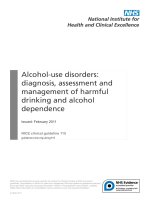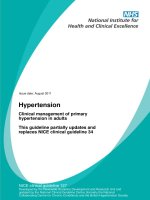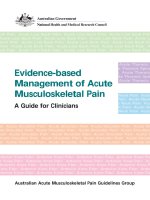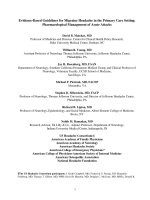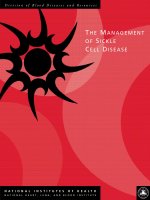Management of lentil wilt through host resistance
Bạn đang xem bản rút gọn của tài liệu. Xem và tải ngay bản đầy đủ của tài liệu tại đây (220.62 KB, 7 trang )
Int.J.Curr.Microbiol.App.Sci (2019) 8(3): 438-444
International Journal of Current Microbiology and Applied Sciences
ISSN: 2319-7706 Volume 8 Number 03 (2019)
Journal homepage:
Original Research Article
/>
Management of Lentil Wilt through Host Resistance
Anshul Arya* and K.P.S. Kushwaha
Department of Plant Pathology, G.B. Pant University of Agriculture and Technology,
Pantnagar, Udham Singh Nagar, 263145, India
*Corresponding author
ABSTRACT
Keywords
Screening,
Fusarium
oxysporum f.sp.
lentis, Wilt, Disease
rating
Article Info
Accepted:
07 February 2019
Available Online:
10 March 2019
Lentil (Lens culinaris) is affected by the wilt disease caused by fungal pathogen Fusarium
oxysporum f.sp. lentis at seedling stage and at the later stages of growth. The pathogen is
soil and seed borne in nature and reported from all lentil growing areas. The present
investigation is on the management of the lentil wilt pathogen by exploiting the resistance
mechanism of the host. Ninety two germplasms were screened along with the local check
(Sehore) under field conditions during the two consecutive years 2016-17 and 2017-18.
The reactions of the host against the pathogen were recorded in the wilt sick plot by
calculating the per cent of number of infected plants over total plants observed. The
germplasms were further categorized into Immune (0 germplasm), Highly Resistant (11
germplasm), Resistant (13 germplams), Moderately Resistant (18 germplams), Susceptible
(40 germplams) and Highly Susceptible (10 germplams) depending on the disease
reaction. Wilt incidence was varied from 0.33 percent to 96.67 percent during the year
2016-17 and 0.75 percent to 93.56 percent during the year 2017-18. None of the screened
germplams was found immune against the disease. Eleven germplasms viz., DL16-5,
DL16-7, VL152, IPL339, IPL340, PL237, RL7-3, RVL15-5, IPL227, IPL338 and IPL332
were found highly resistant to the disease under the field conditions. The present
investigation suggests that the resistance in the lentil germplasms can be exploited for the
management of the seed and soil borne pathogens and is an effective management practice
with less use of inputs.
seed quality, insect and diseases. Among the
diseases, losses caused by wilt disease
causing pathogen Fusarium oxysporum f.sp.
lentis are severe. Most of the lentil cultivated
areas are reported to have this devastating
disease in mild to severe form. The pathogen
survives in soil as well as in seeds for several
years. Pathogen infects the plants in all
growth stages from seedling to flowering
stage. It was observed that the Warm (25°C)
and dry conditions are the most ideal
Introduction
Lentil is an oldest pulse grown globally in
different countries like in India, Pakistan,
Bangladesh, Italy etc. This pulse is rich
source of protein and some other amino acids
like lysine and tryptophane. It provides
balance nutrition to the humans and its straw
is also used as animal feed (Bayaa et al.,
1997). Losses in lentil production are
governed by several factors including poor
438
Int.J.Curr.Microbiol.App.Sci (2019) 8(3): 438-444
condition for the proliferation of the disease
(Bayaa and Erskine 1990). Management of
this devastating disease is very necessary to
reduce the yield losses of lentil. As
management of pathogen in soil with
chemicals is difficult due to lack of
techniques of infusing chemicals in soil,
moreover, chemicals are hazardous for the
environment and require more expenses;
therefore, management of this pathogen
requires some sustainable solution that
includes development of resistant varieties of
lentil for field use. These resistant
germaplasms are eco friendly and feasible,
having the potential of resisting the soil borne
diseases. Stoilova and Chavdarov (2006)
screened thirty two genotypes of lentil against
the wilt pathogen and reported the nine
germplasms viz., 91-009, 91-011, 93-002, 93040, 95-005, 98-001, 98-013, 2000LEN464
and 2000LEN466, resistant with seedling
mortality of 15 percent during all the
experiment in the year 2003-2004.
Mohammadi et al., (2012) screened 55 lentil
germplams and reported three germplams
(81S15, FLIP2007-42 L and FLIP2009-18 L)
resistant against the wilt disease of lentil.
Rafique et al., (2016) reported the five
cultivars viz., Markaz-09, Masoor-86,
Masoor-2006, Punjab Masoor-00518 and
Punjab Masoor-09 resistant to wilt pathogen
with 20 to 46.67 percent wilt incidence.
Meena et al., (2017) reported lentil
germplasms IG 69549 and IG 70238 as highly
resistant genotypes based on field and
controlled condition screening against wilt
pathogen.
against the soil borne pathogen Fusarium
oxysporum f.sp. lentis. The germplasms were
screened in the wilt sick plot containing the
2.25x103 CFU of the pathogen and germplams
were sown in each plot having size of 4.5
meter2. The susceptible check (Sehore) was
sown between every two rows of germplams
as infector. All experiment was conducted in
randomized block design maintaining three
replications for each entry. Data collection on
the basis of symptoms of plant was done at
the two stages of plant growth at seedling
stage and at flowering stage. The percent
disease incidence was also recorded for each
germplasm to see the disease impact on the
plants. The following formula was used for
the calculation of the percent wilt incidence.
DI (%) =
No. of infected plants X
100
Total no. of plants
observed
The level of resistance existing in the
germplasms was determined by using the 1 to
6 disease rating scale (Table 1) given by
MULLaRP in technical programme with
some modification.
Results and Discussion
Screening of ninety two lentil germplasms
(Table 2) was done against the soil borne
pathogen Fusarium oxysporum f.sp. lentis in
the wilt sick plot. The uniform distribution of
the pathogen inoculums in the wilt sick plot
was determined by the hundred percent wilt
incidence in the susceptible lentil check
(Sehore). The diseased plants showed the
yellowing of the leaves started from lower
leaves and moved upwards thereby drying of
the whole plant. The percent incidence of the
wilt disease was obtained as a percent of
number of plants infected with the disease out
of total number of plants observed. The
germplasms were further categorized (Table
Materials and Methods
The present research was conducted during
the two consecutive years 2016-17 and 201718 in the NE Borlaug Crop Research Centre
at GBPUAT, Pantnagar, Udham Singh Nagar.
Ninety two lentil germplasms along with the
susceptible check Sehore were screened
439
Int.J.Curr.Microbiol.App.Sci (2019) 8(3): 438-444
3) into immune, highly resistant, resistant,
moderately resistant, susceptible and highly
susceptible with the help of 1 to 6 disease
rating scale depending on their disease
reaction and percent of disease incidence. Out
of ninety two germplasms screened none of
the germplasms was found free from the
diseases infection. Eleven germplams viz.,
DL16-5, DL16-7, VL152, IPL339, IPL340,
PL237, RL7-3, RVL15-5, IPL227, IPL338
and IPL332 were found highly resistant.
RKL14-114) were found moderately resistant
to the disease showing the range of percent
wilt incidence from 10.33 percent (VL507) to
19.67 percent (LL1373 and RVL 14-4) during
the year 2016-17 and during the year 2017-18
wilt incidence varied from 11.87 percent (IPL
406) to 20.00 percent (PL245).
Forty germplasms (LL 1320, NDL 14-12,
L4751, PL406, LL1397, NDL 2016-15,
KLS143, LL1383, LL1386, IPL233, IPL 245,
VL153, BRL 1, BRL-2, LH 84-8, NDL 201624, KLB112, RVL15-1, RVL15-4, LL1396,
LL1467, JLS-1, RKL603-5, VL528, L4728,
BPL 16, HUL57, L 4076, JL 3, DPL 62, IPL
316, RKL 14-20, RVL 13-5, RVL 13-7, L
4727, DPL 15, L4773, RKL611-3 and
K75,IPL526) were found susceptible showing
the percent wilt incidence from 21.00 percent
(IPL526 and JLS-1) to 49.33 percent (RKL
14-20) during first year of experiment and
21.00 percent (L 4076) to 49.52 percent (LH
84-8) during the year 2017-18. Ten
germplasms viz., IPL230, L 4756, L 4757,
KLS218, RL6-1, RL3-5-1, LH1407, IPL81,
IPL232 and RL11-07 were found highly
susceptible showing percent disease incidence
ranging from 54.33 percent (IPL81) to 96.67
percent (L 4757) during the year 2016-17 and
57.26 percent (IPL81) to 91.25 percent (RL61) during the year 2017-18.
The disease incidence was found minimum in
germplasm RVL15-5 that was 0.33 percent
wilt incidence during the year 2016-17 and
0.77 percent wilt incidence during the year
2017-18. Thirteen germplams viz., VL148,
RKL605-3, PL245, VL527, L4729, L4771,
IPL535, PL 024, IPL336, IPL536, IPL221,
IPL222 and IPL225 were found resistant
against the pathogen. The percent of wilt
incidence for resistant germplasms was varied
from minimum 5.67 percent in germplasm
IPL221 to maximum 9.33 percent in VL527
germplasm during the year 2016-17 and 5.26
percent (L4771 and RKL605-3) to 10.00
percent (VL527 and IPL535) during the year
2017-18. Eighteen germplasms (PL 4, L 4147,
VL126, LL1370, PL063, RLG250, PL233,
PL224, PL221, VL507, JLS-3, L4769, RVL
14-4, IPL 406, LL1373, L4772, IPL537 and
Table.1 Disease rating scale for lentil wilt disease caused by Fusarium oxysporum f.sp. lentis
RATING
% Infected Plants
Disease reactions
1
0% infection
Immune (I)
2
0.1 to 5% plants
Highly Resistant (HR)
3
5.1 to 10% plants wilted
Resistant (R)
4
10.1 to 20% plants wilted
Moderately resistant (MR)
5
20.1-50 % plants wilted
Susceptible (S)
6
Above 50%
Highly Susceptible (HS)
440
Int.J.Curr.Microbiol.App.Sci (2019) 8(3): 438-444
Table.2 Screening of lentil germplams against the wilt pathogen Fusarium oxysporum f.sp. lentis
S. No.
Genotype
Wilt incidence
(%)2016
Wilt incidence
(%)2017
Reaction
S. No.
Genotype
Wilt
incidence
(%) 2016
Wilt incidence
(%) 2017
Reaction
1.
PL 4
19.33
18.42
MR
47.
PL221
17.22
18.45
MR
2.
L 4147
17.00
15.71
MR
48.
LH 84-8
47.67
49.52
S
3.
VL126
16.33
17.26
MR
49.
VL507
10.33
12.00
MR
4.
VL148
7.67
5.26
R
50.
NDL 2016-24
25.33
26.34
S
5.
LL 1320
25.82
27.23
S
51.
RL6-1
89.00
91.25
HS
6.
NDL 14-12
43.00
41.26
S
52.
RL3-5-1
79.33
81.25
HS
7.
L4751
35.67
38.21
S
53.
LH1407
71.00
73.25
HS
8.
LL1370
16.67
15.53
MR
54.
KLB112
33.00
29.56
S
9.
PL406
27.67
29.38
S
55.
RVL15-1
25.33
27.13
S
10.
PL063
18.67
16.52
MR
56.
RVL15-4
26.33
25.66
S
11.
LL1397
47.33
45.32
S
57.
LL1396
45.67
47.21
S
12.
IPL230
81.00
76.32
HS
58.
LL1467
27.67
30.04
S
13.
NDL 2016-15
40.67
38.26
S
59.
JLS-1
21.00
23.52
S
14.
KLS143
23.33
21.22
S
60.
JLS-3
19.33
18.36
MR
15.
LL1383
46.67
48.23
S
61.
IPL339
4.00
3.01
HR
16.
LL1386
37.00
37.82
S
62.
IPL340
2.67
4.25
HR
17.
IPL233
33.00
31.26
S
63.
RKL603-5
32.00
29.42
S
18.
IPL 245
39.33
41.23
S
64.
RKL605-3
7.00
5.23
R
19.
RLG250
16.00
17.21
MR
65.
PL245
19.33
20.00
R
20.
PL233
11.33
13.55
MR
66.
PL237
5.00
4.61
HR
21.
PL224
13.00
14.75
MR
67.
VL527
9.33
10.00
R
22.
DL16-5
2.33
4.00
HR
68.
VL528
34.33
36.47
S
441
Int.J.Curr.Microbiol.App.Sci (2019) 8(3): 438-444
23.
DL16-7
2.67
3.12
HR
69.
L4728
45.67
47.25
S
24.
VL152
1.33
2.01
HR
70.
L4729
8.00
9.23
R
25.
VL153
25.00
27.33
S
71.
L4769
15.00
13.58
MR
26.
BRL 1
42.00
43.23
S
72.
L4771
7.00
5.26
R
27.
BRL-2
36.00
39.22
S
73.
RL7-3
4.67
3.42
HR
28.
L 4756
58.67
63.23
HS
74.
IPL535
8.00
10.00
R
29.
L 4757
96.67
93.56
HS
75.
IPL536
8.00
9.44
R
30.
BPL 16
48.00
45.12
S
76.
RVL15-5
0.33
0.75
HR
31.
KLS218
69.67
65.23
HS
77.
L4772
15.67
17.25
MR
32.
HUL57
46.67
43.32
S
78.
L4773
45.67
47.25
S
33.
L 4076
22.67
21.00
S
79.
IPL537
14.00
13.25
MR
JL 3
42.00
40.85
S
80.
RKL14-114
14.67
14.00
MR
35.
DPL 62
22.67
21.36
S
81.
RKL611-3
28.67
31.25
S
36.
IPL 316
42.00
40.26
S
82.
K75
32.00
34.15
S
37.
RKL 14-20
49.33
47.25
S
83.
IPL81
54.33
57.26
HS
38.
RVL 13-5
32.00
29.55
S
84.
IPL221
5.67
7.45
R
39.
RVL 13-7
39.67
41.13
S
85.
IPL222
10.00
9.45
R
40.
L 4727
22.67
24.32
S
86.
IPL225
6.67
7.45
R
41.
RVL 14-4
19.67
20.00
MR
87.
IPL227
2.67
3.00
HR
42.
DPL 15
24.33
21.58
S
88.
IPL338
4.00
4.75
HR
43.
IPL 406
13.67
11.87
MR
89.
IPL332
3.67
4.00
HR
44.
PL 024
8.00
9.11
R
90.
IPL232
62.00
64.25
HS
45.
LL1373
19.67
18.23
MR
91.
IPL526
21.00
23.33
S
46.
IPL336
6.67
7.84
R
92.
RL11-07
76.33
74.12
HS
34.
442
Int.J.Curr.Microbiol.App.Sci (2019) 8(3): 438-444
Table.3 Categorization of the lentil germplasms on the basis of disease reaction against
Fusarium oxysporum f.sp. lentis
S.No.
Disease
Reactions
Immune
Highly
Resistant (11)
Germplasms
3.
Resistant(13)
VL148, RKL605-3, PL245, VL527, L4729, L4771, IPL535, PL
024, IPL336
IPL536, IPL221, IPL222, IPL225
4.
Moderately
resistant (18)
PL 4, L 4147, VL126, LL1370, PL063, RLG250, PL233, PL224,
PL221, VL507, JLS-3, L4769, RVL 14-4, IPL 406, LL1373,
L4772, IPL537, RKL14-114
5.
Susceptible
(40)
LL 1320, NDL 14-12, L4751, PL406, LL1397, NDL 2016-15,
KLS143, LL1383, LL1386, IPL233, IPL 245, VL153, BRL 1,
BRL-2, LH 84-8, NDL 2016-24, KLB112, RVL15-1, RVL15-4,
LL1396, LL1467, JLS-1, RKL603-5, VL528, L4728, BPL 16,
HUL57, L 4076, JL 3, DPL 62, IPL 316, RKL 14-20, RVL 13-5,
RVL 13-7, L 4727, DPL 15, L4773, RKL611-3, K75,IPL526
6.
Highly
IPL230, L 4756, RL6-1, RL3-5-1, LH1407, L 4757, KLS218,
Susceptible(10) IPL81, IPL232
RL11-07
1.
2.
Nil
DL16-5, DL16-7, VL152, IPL339, IPL340, PL237, RL7-3,
RVL15-5, IPL227, IPL338, IPL332
The results obtained are similar to the results
obtained by some other researchers those also
found the resistant cultivars through screening
of germplasms using sick plot technique.
Soomro et al., (2018) revealed that NIAMasoor-05, lentil-25 was comparatively
resistant against infection of wilt pathogen
followed by Masoor-93 and Markaz-09.
Koleva et al., (2018) reported six lentil
accessions (two cultivars and four lines) as
moderately
resistant
phenotype
after
inoculation with Fusarium oxysporum f.sp.
lentis.
The present study concluded that the one
germplasm RVL15-5 was found highly
resistant to the disease as it showed the
percent wilt incidence less than 1 percent in
both years of experiment. The germplasm like
VL152 (1.33%), DL16-5 (2.33%), IPL340
(2.67%), IPL227 (2.67%), DL16-7 (2.67%),
IPL332 (3.67%), IPL338 (4.00%), IPL339
(4.00%), RL7-3 (4.67%) and PL237 (5.00%)
etc. were also found highly resistant for the
disease. The present study revealed that the
inherent ability of the host plant to resist the
pathogen allow the host to survive under the
443
Int.J.Curr.Microbiol.App.Sci (2019) 8(3): 438-444
abundance of the pathogen inoculums without
economic damage to the host and does not
require any other inputs for disease escape.
Use of the resistant germplasms is eco
friendly approach for the disease management
as well as economical for the farmers and
could be a part of Integrated Disease
Management practices.
culinaris)
Germplasm
against
Fusarium Wilt (Fusarium oxysporum
f. sp. lentis). International Journal of
Current Microbiology and Applied
Science. 6(11): 2533-2541.
Mohammadi N, Puralibaba H, Goltapeh EM,
Ahari AB and Sardrood BP. 2012.
Advanced lentil lines screened for
resistance to Fusarium oxysporum f.
sp. lentis under greenhouse and field
conditions. Phytoparasitica. 40:69–76.
Rafique K, Rauf CA, Naz F and Shabbir
G.2016. Management of Vascular
Wilt of Lentil through Host Plant
Resistance, Biological Control Agents
and Chemicals. Pakistan Journal of
Botany 48(5): 2085-2092.
Soomro MP, Wagan KH, Dhiloo KH, Soomro
SP, Soomro MH, Hassan S, Yaseen
M, Hajano J, Mastoi SM and Mastoi
PM. 2018. Response of lentil varieties
against Fusarium wilt. Journal of
Entomology and Zoology Studies.
6(1): 858-862.
Stoilova T and Chavdarov P. 2006.
Evaluation of Lentil Germplasm For
Disease Resistance To Fusarium Wilt
(Fusarium oxysporum f.sp. lentis).
Journal
of
Central
European
Agriculture. 7(1): 121-126.
References
Bayaa B, Erskine W and Singh M. 1997.
Screening lentil for resistance to
Fusarium wilt: methodology and
source of resistance. Euphytica. 98:6974.
Bayaa, B. and Erskine, W. 1990. A screening
technique for resistance to vascular
wilt in lentil. Arab Journal of Plant
Protection. 8: 30-33.
Koleva M, Stanoeva Y, Kiryakov I, Ivanova
A, Chamurlyiski P. 2018. Evaluation
of lentil cultivars and lines for
resistance to Fusarium oxysporum
f.sp. lentis. Agricultural Science and
Technology. 10(1): 25-28.
Meena JK, Singh A, Dikshit HK, Mishra GP,
Aski M, Srinivasa N, Gupta S, Singh
D and Tripathi A. 2017. Screening of
Lentil (Lens culinaris Medikus sub sp.
How to cite this article:
Anshul Arya and Kushwaha, KPS. 2019. Management of Lentil Wilt through Host Resistance.
Int.J.Curr.Microbiol.App.Sci. 8(03): 438-444. doi: />
444
